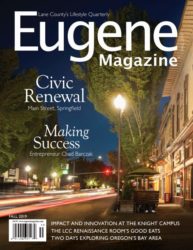Civic Stadium was built in 1938, a place of massive timbers and a stunning view of Eugene’s east hills. Originally designed for high school football and baseball, the stadium later carved an identity as home to the Eugene Emeralds minor league baseball team. When the Emeralds moved to the University of Oregon sports complex in 2009, Civic forfeited its claim as one of the most distinctive minor league parks in America.
Then, in June 2015, the stadium burned to the ground, destroyed by teens playing with fire a mere two months after a grassroots community nonprofit, the Eugene Civic Alliance, purchased the stadium property with a dream to restore the site as a sports and recreation venue.
Since the fire, the site has seemed silently resolute, almost ghostly. The blackened steel and timber have slowly disappeared. More recently, a simple mural appeared on an east-facing concrete wall. That’s the extent of any visible change.
What’s gone largely unnoticed are the behind-the scenes efforts of the ECA to bring form and excitement back to the site. And now that excitement is about to take flight in the form of a multi-sport turf field for kids that will also showcase Lane United soccer events. The new facility will also include a 2,500-seat grandstand, twin outdoor multi-sport courts, and a 40,000-square-foot KidsSports field house with space for middle school and high school basketball and volleyball courts.
KidsSports Director Bev Smith offers an insider’s perspective on how Civic Park will remedy the local shortage of gym and field space for kids.
“This is fundamental to our ability to raise healthy kids and have them grow into active adults,” Smith says. “I’m not talking about training elite athletes. We’re talking about basic physical skills and habits everyone should learn by the time they are 11 or 12.”
ECA Co-Executive Director Nancy Webber has a more pragmatic focus.
“We’ve raised more than 50 percent of the $35 million in funds needed for construction,” she says. “And we will be at 80 percent before we begin construction this spring.”
Civic Park is poised to rise up like a phoenix from the ashes.

